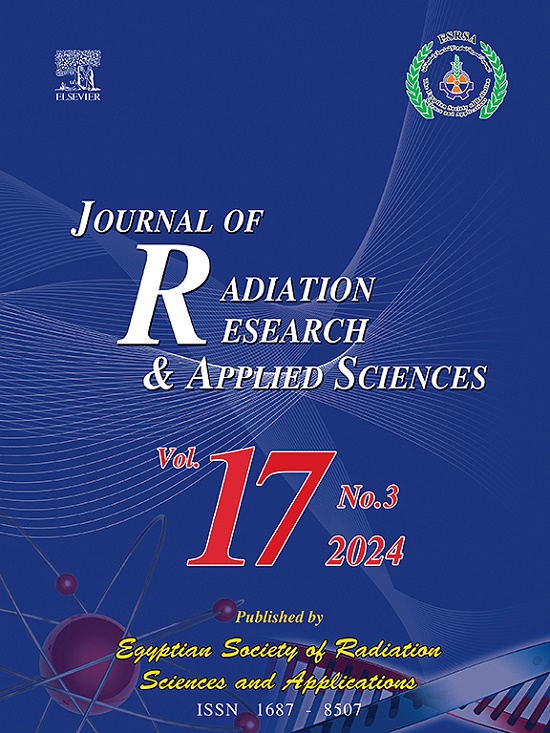Effects of nanoparticle radius and interparticle spacing on three-dimensional water-based gold nanofluid flow over a convectively heated extending sheet: A numerical study
IF 1.7
4区 综合性期刊
Q2 MULTIDISCIPLINARY SCIENCES
Journal of Radiation Research and Applied Sciences
Pub Date : 2025-03-23
DOI:10.1016/j.jrras.2025.101417
引用次数: 0
Abstract
Applications for the impacts of nanoparticle radius and interparticle spacing on nanofluid flow using gold nanoparticles may be found in several domains, such as advanced materials, microfluidics, and thermal management. A gold nanofluid flowing on a bidirectional expanding sheet is studied in this work, considering gyrotactic microorganisms, zero mass flux, convective limitations at the border, and other significant applications. It investigates the impression of nanoparticle radius and interparticle spacing on the flow system's overall dynamics. The heat and mass flow investigation also considers the Cattaneo-Christov flux model. To investigate the nanofluid flow, the effects of thermophoresis, Brownian motion, and chemical reaction are taken into consideration. The modeled equations are converted to dimension-free format using suitable variables and then solved by the homotopy analysis method (HAM). It has noticed as the outcome of this work that, with growth in porosity factor, inter-particle spacing factor, and magnetic factor both velocities are declined and escalated with an upsurge in nanoparticle radius. Thermal distributions have grown with increases in thermal Biot number, thermophoresis factors, and Brownian motion; but, with increases in thermal relaxation time factor, they have decreased. The greater Schmidt number, chemical reaction and mass relaxation time factors have declined the molar concentration distribution. Microorganisms' distribution of nanofluid has declined with an upsurge in bio-convective Lewis and Peclet numbers. A comparison of current work with published results has been conducted and a fine agreement has been observed amongst these results.
纳米颗粒半径和颗粒间距对三维水基金纳米流体在对流加热扩展板上流动的影响:数值研究
纳米颗粒半径和颗粒间距对纳米流体流动影响的应用可以在几个领域找到,如先进材料、微流体和热管理。本文研究了在双向膨胀片上流动的金纳米流体,考虑了回旋式微生物、零质量通量、边界对流限制和其他重要应用。研究了纳米颗粒半径和颗粒间距对流动系统整体动力学的影响。热流和质量流的研究也考虑了Cattaneo-Christov通量模型。为了研究纳米流体的流动,考虑了热泳、布朗运动和化学反应的影响。采用合适的变量将模型方程转换为无维格式,然后用同伦分析法求解。我们注意到,随着孔隙度因子、颗粒间距因子和磁性因子的增加,这两种速度都随着纳米颗粒半径的增加而下降和上升。热分布随着热生物数量、热泳因子和布朗运动的增加而增大;但随着热松弛时间因子的增大,它们逐渐减小。随着施密特数、化学反应和质量弛豫时间的增大,摩尔浓度分布减小。微生物在纳米流体中的分布随着生物对流Lewis和Peclet数的增加而下降。目前的工作与已发表的结果进行了比较,并在这些结果之间观察到一个很好的协议。
本文章由计算机程序翻译,如有差异,请以英文原文为准。
求助全文
约1分钟内获得全文
求助全文
来源期刊

Journal of Radiation Research and Applied Sciences
MULTIDISCIPLINARY SCIENCES-
自引率
5.90%
发文量
130
审稿时长
16 weeks
期刊介绍:
Journal of Radiation Research and Applied Sciences provides a high quality medium for the publication of substantial, original and scientific and technological papers on the development and applications of nuclear, radiation and isotopes in biology, medicine, drugs, biochemistry, microbiology, agriculture, entomology, food technology, chemistry, physics, solid states, engineering, environmental and applied sciences.
 求助内容:
求助内容: 应助结果提醒方式:
应助结果提醒方式:


